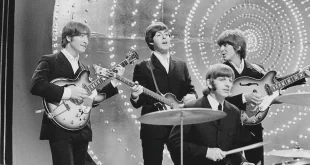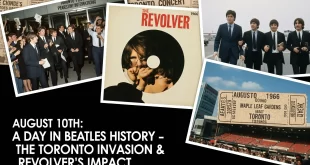OCTOBER 10, 1939 – Eleanor Rigby died in her sleep of unknown causes at the age of 44. But according to songwriter Paul McCartney, the 1966 Beatles’ song that featured her name wasn’t written about her. In fact, McCartney’s first draft of the song’s melody came to him as he experimented with his piano, and he originally named the character Miss Daisy Hawkins.Paul explained: “I was sitting at the piano when I thought of it. The first few bars just came to me, and I got this name in my head … ‘Daisy Hawkins picks up the rice in the church.’ I don’t know why I couldn’t think of much more so I put it away for a day.
Then the name Father McCartney came to me, and all the lonely people. But I thought that people would think it was supposed to be about my Dad sitting knitting his socks. Dad’s a happy lad. So I went through the telephone book and I got the name McKenzie…”McCartney said he came up with the name “Eleanor” from actress Eleanor Bron, who had starred with the Beatles in the film “Help!” “Rigby” came from the name of a store in Bristol, “Rigby & Evens Ltd, Wine & Spirit Shippers” which he noticed while seeing his girlfriend of the time (Jane Asher) act in “The Happiest Days of Your Life.”He recalled in 1984, “I just liked the name. I was looking for a name that sounded natural. ‘Eleanor Rigby’ sounded natural.” However, it has been pointed out that the graveyard of St. Peter’s Church in Liverpool, where John Lennon and Paul McCartney first met at the Woolton Village garden fete in the afternoon of July 6, 1957, contains the gravestone of an individual called Eleanor Rigby.
Paul McCartney has conceded he may have been subconsciously influenced by the name on the gravestone. The real Eleanor Rigby lived a lonely life similar to that of the woman in the song.McCartney couldn’t decide how to end the song, and Shotton finally suggested that the two lonely people come together too late as Father McKenzie conducts Eleanor Rigby’s funeral. At the time, Lennon rejected the idea out of hand, but McCartney said nothing and used the idea to finish off the song, later acknowledging Shotton’s help.Lennon was quoted in 1972 as having said that he wrote 70% of the lyrics, and in 1980 claimed that he wrote all but the first verse, but Pete Shotton, Lennon’s childhood friend, remembered Lennon’s contribution as being “absolutely nil.” Donovan also reported that he heard McCartney play it to him before it was finished.In the 1980s, a grave of an Eleanor Rigby was “discovered” in the graveyard of St. Peter’s Parish Church in Woolton, Liverpool, and a few yards away from that, another tombstone with the last name McKenzie scrawled across it.
During their teenage years, McCartney and Lennon spent time sunbathing there, within earshot of where the two had met for the first time during a fete in 1957. Many years later McCartney stated that the strange coincidence between reality and lyric could be a product of his subconscious, rather than being a meaningless fluke.One Eleanor Rigby was born in 1895 and lived in Liverpool, possibly in the suburb of Woolton, where she married a man named Thomas Woods. Whether this Eleanor was the inspiration for the song or not, her tombstone has become a landmark to Beatles’ fans visiting Liverpool.
A digitized version was added to the 1995 music video for The Beatles’ reunion song “Free as a Bird.”In June 1990, McCartney donated a document dating from 1911 which had been signed by a 16-year-old Eleanor Rigby to Sunbeams Music Trust, instantly attracting significant international interest from collectors because of the significance and provenance of the document. The nearly 100-year-old document was sold at auction in November 2008 for £115,000 ($250,000). The Daily Telegraph reported that the uncovered document is a 97-year-old salary register from Liverpool City Hospital. The name E. Rigby is printed on the register, and she is identified as a scullery maid. It’s well-known that in 1946 the McCartney’s moved to 72 Western Avenue in Speke. In 1948, the family moved again to 12 Ardwick Road (also in Speke) which was part of a new estate in the suburbs of Liverpool where they stayed until they moved to Forthlin Road in 1955. By amazing coincidence another Eleanor Rigby was actually born in Speke in 1900, just a stones-throw from Paul McCartney’s childhood house in Ardwick Road. In-fact the Rigby’s had lived in Speke since at least the mid 1800’s and the family even appears on the Speke Census of 1881 living at 32 Cottage.It is reasonable to assume that Eleanor was the daughter of William J Rigby who by 1900 was 33 years of age. Eleanor was actually christened “Eleanor Maud Rigby” and had at least two brothers: Reginald and Jim Rigby and one sister Dolly Rigby. Not much is known about Eleanor’s early life except that she worked as a domestic servant from the age of 11 and by the age of 16 had spent some time working at the Adelphi Hotel in central Liverpool. It was a lowly paid existence with very long hours of work. Young girls where often expected to go “into service” at a very young age, often as young as 8.
It was either that or go to the workhouse. In her mid-twenties, Eleanor went on a bicycle ride with some friends to the nearby village of Hale; here she met a young journeyman named Thomas Battle, a travelling joiner and wheelwright from Kilkenny in Ireland. Thomas was to become Eleanor’s husband and with little or no money the couple moved to a caravan in Dragon Lane, Whiston.At the age of 29 Eleanor Rigby (now Eleanor Maud Battle) had her first son, a boy named Peter James, born on March 21, 1929 in “the brown caravan” in Dragon Lane, Whiston. Peter was the first of six sons closely followed by Thomas, also born in the caravan on April 20, 1930.The brown caravan was now becoming rather small for a growing, young family and shortly after the birth of young Tommy they moved to their new home in Warrington Road, Rainhill, it was here that Peter and Tommy spent their formative years and the place where Eleanor had four more sons, William, Jack, Norman and Charles Reginald.In 2004, “Eleanor Rigby” was ranked #137 on Rolling Stone Magazine’s list of “The 500 Greatest Songs of All Time.”
LYRICS:
Ah, look at all the lonely people
Ah, look at all the lonely people
Eleanor Rigby picks up the rice in the church where a wedding has been
Lives in a dream
Waits at the window, wearing the face that she keeps in a jar by the door
Who is it for?
All the lonely people
Where do they all come from?
All the lonely people
Where do they all belong?
Father McKenzie writing the words of a sermon that no one will hear
No one comes near
Look at him working, darning his socks in the night when there’s nobody there
What does he care?
All the lonely people
Where do they all come from?
All the lonely people
Where do they all belong?
Ah, look at all the lonely people
Ah, look at all the lonely people
Eleanor Rigby died in the church and was buried along with her name
Nobody came
Father McKenzie wiping the dirt from his hands as he walks from the grave
No one was saved
All the lonely people (Ah, look at all the lonely people)
Where do they all come from?
All the lonely people (Ah, look at all the lonely people)
Where do they all belong?





